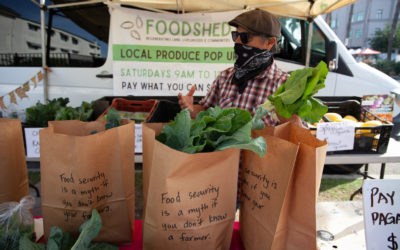Becoming a subscriber to Foodshed’s Fresh 5 program—a weekly distribution of fresh, seasonal produce, grown by the small farmers who make up the Foodshed cooperative—means you’re in for two surprises with every delivery. One is the produce itself: an ever-changing...
OBJECTIVE 1 | THE DASHBOARD
Preserve Agricultural Land and Soils, and Commit to Long-term Food Production
Indicator
Land in Agriculture in San Diego County
Is land in agriculture in San Diego County increasing?
No, land in agriculture in San Diego County has decreased over the past several decades to a current level of about 234,000 acres. As recently as 1954, San Diego County had nearly 1 million acres in agriculture—about 36% of the county’s land area. Today, about 80% of land in agriculture is rangeland, but field crops account for less than 1% of agricultural sales.
About the data
Source: County of San Diego Department of Agriculture, Weights, and Measures, Crop Statistics & Annual Report
Last updated: June 1, 2021
Indicator
Total Agricultural and Seafood Sales in San Diego County
Are total agricultural and seafood sales in San Diego County increasing?
Agricultural sales in San Diego County have been relatively consistent over the past 20 years, hovering between sales of $1.8 to $2.0 billion per year. Nursery/greenhouse products (65.4%) and cut flower products (3.7%) accounted for about 73% ($1.32 billion) of the value of total agricultural and seafood products in San Diego County in 2019. Fruits and nuts equaled 18.9% ($342 million) of total sales, while vegetables added 7.2% ($131 million) of total sales. Livestock and poultry products—mainly eggs—contributed 3.3% ($59 million) of total sales. The value of total seafood products equaled 0.6% ($11.4 million) of total sales.
About the data
Source: County of San Diego Department of Agriculture, Weights, and Measures, Crop Statistics & Annual Report; California Department of Fish and Wildlife, Final California Commercial Landings
Last updated: June 1, 2021
Note: Adjusted for inflation to 2019 dollars. The 2019 value for Livestock and Poultry Products (e.g., eggs) was combined with Livestock and Poultry.
Indicator
Total Edible Agricultural and Seafood Sales in San Diego County
Are edible agricultural and seafood sales in San Diego County increasing?
No, the value of edible agricultural and seafood sales has trended downward. Fruits, mostly Hass avocados and citrus, accounted for about 63% of the value of edible food production in San Diego County in 2019. Vegetables, mostly tomatoes and miscellaneous vegetables, made up 24% ($130 million) of sales. Of the remaining 13%, eggs (6.4%, $34 million in 2018, 2019 sales values were suppressed) make up the next largest percent, followed by cattle and calves (2.4%, $13 million), seafood (2.1%, $11.4 million), chickens (0.9%, $4.8 million), field crops (mostly rangeland, 1.3%, $6.8 million), and apiary products (0.7%, $3.5 million in 2018)
About the data
County of San Diego Department of Agriculture, Weights, and Measures, Crop Statistics & Annual Report; California Department of Fish and Wildlife, Final California Commercial Landings
Last updated: June 1, 2021
Note: Adjusted for inflation to 2019 dollars.
Indicator
Fruit Acreage and Sales in San Diego County
Is land in agriculture in vegetables in San Diego County increasing?
No, fruit acreage in San Diego County has declined significantly. Oranges and Hass avocados accounted for 66% of total fruit acreage in 2019. From 2000 to 2019, orange acreage decreased 37% (-3,066 acres), Hass avocado acreage decreased about 28% (-6,387 acres). During that same period, wine grape acreage increased 763% (+1,336 acres).
About the data
Source: County of San Diego Department of Agriculture, Weights, and Measures, Crop Statistics & Annual Report
Last updated: June 1, 2021
Note: Adjusted for inflation to 2019 dollars.
Indicator
Vegetable Acreage and Sales in San Diego County
Is land in agriculture in vegetables in San Diego County increasing?
No, there was a steep drop in acres of vegetables and vine crops, from 9,240 acres in 2000, to 3,164 acres in 2020, a 66% decrease. Tomatoes and a catch-all category called miscellaneous vegetables account for most sales.
About the data
Source: County of San Diego Department of Agriculture, Weights, and Measures, Crop Statistics & Annual Report
Last updated: June 1, 2021
Note: Adjusted for inflation to 2019 dollars. The 2019 values for Tomatoes and Peppers were combined with miscellaneous vegetables.
Indicator
Fisheries Landings and Seafood Sales in San Diego County
Are San Diego County seafood landings and sales increasing?
Yes, despite major shifts in regulatory pressures, growth of fishing fleets in other countries, rising imports, and other shifts in the 1980s that made it challenging for local fishermen to make a living, sales have been trending upward over the past 20 years.
About the data
Source: California Department of Fish and Wildlife, Final California Commercial Landings
Last updated: June 1, 2021
Note: Adjusted for inflation to 2019 dollars.
Indicator
San Diego County Farmer Age Demographics
Is the average age of San Diego County farmers increasing?
Yes, the average age of farmers has increased across California over the past several decades, including in San Diego County. But, San Diego County also has large cohorts of Young Producers (age 35 and younger) and New and Beginning Producers (producers operating on a farm for 10 years or less).
About the data
Source: USDA Census of Agriculture
Last updated: June 1, 2021
Indicator
San Diego County Farmer Race/Ethnicity Demographics
Is the diversity of San Diego County farmers increasing?
No, the vast majority of farms and land in agriculture in California and San Diego County are operated by White producers for all available years of the Census of Agriculture (note that we only depict 4 years). San Diego County has the most relatively diverse producers of any county in California.
About the data
Source: USDA Census of Agriculture
Last updated: June 1, 2021
Indicator
Major Climate Risks in California
Are climate risks for San Diego County’s food system increasing?
Yes, there is sufficient evidence that California’s climate has changed significantly, will continue to do so, and has already impacted agricultural production. The greatest risk in San Diego County, as in much of the Western U.S., is very high water stress due to drought and water demand. The severity of wildfires and extended periods of drought have increased. Some regions of California have already surpassed warming of 1.5 degrees Celsius, a critical threshold for avoiding the worst consequences of climate change.
About the data
Source: Drought: U.S. Drought Monitor; Wildfires: CalFire; Temperature change and top climate risk: the Washington Post, https://github.com/washingtonpost/data-2C-beyond-the-limit-usa.
Last updated: June 1, 2021





